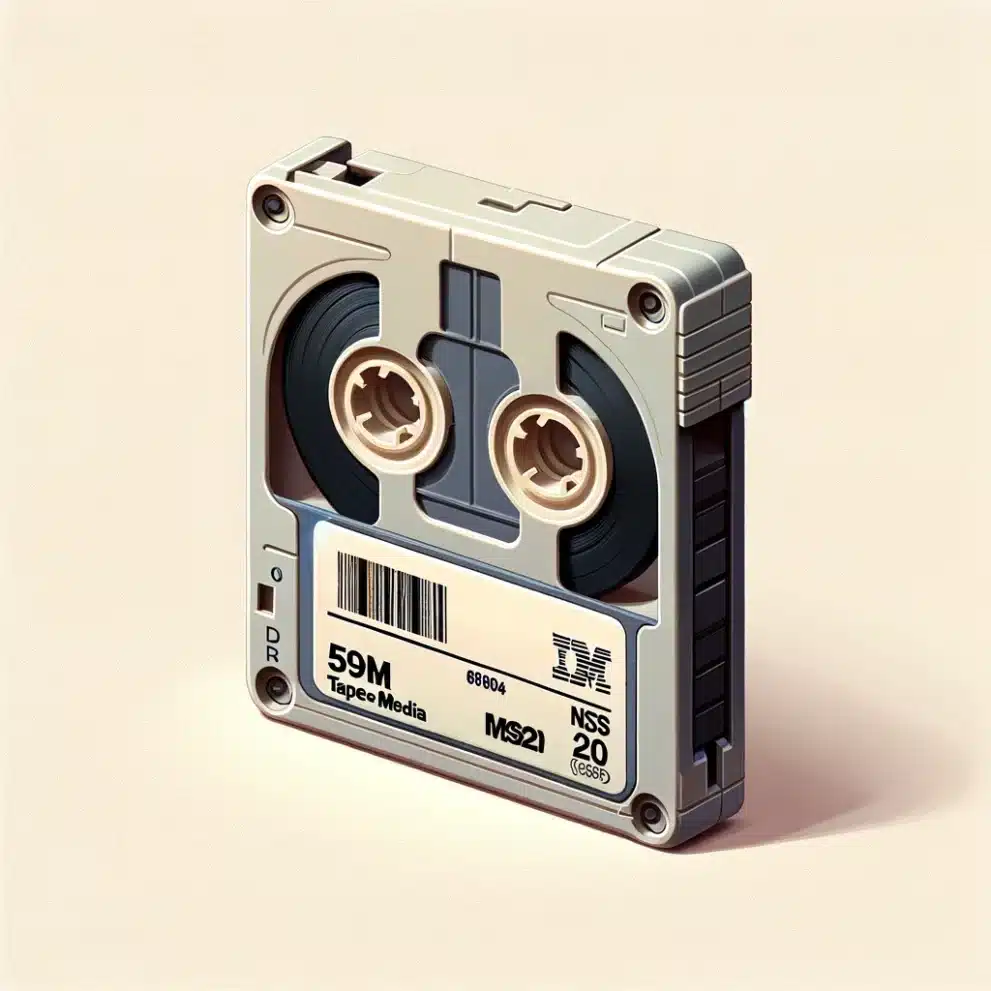
The IBM 59H4364 refers to a Travan Tape Media NS20, which is a type of data storage tape. It has a capacity of 20GB and is used for secure and reliable data storage. This tape media is designed to be used with compatible tape drives for data backup and archiving purposes.
The IBM 59H4364 Travan Tape Media NS20 was commonly used in the late 1990s and early 2000s. Travan technology was more prevalent during this period for small business and personal data backup solutions due to its affordability and sufficient storage capacity for the needs of that era. As technology evolved and the demand for higher capacity and faster data transfer rates grew, more advanced storage solutions gradually replaced Travan tapes.
You can find the IBM 59H4364, a Travan Tape Media NS20, primarily through online marketplaces such as Amazon or eBay, where both new and used options are often listed. Specialized IT hardware suppliers and stores focusing on business or enterprise solutions may also carry this type of tape media. Given the specific nature of this product, it’s beneficial to consider vendors specializing in data storage and backup solutions, as they are likely to offer a wider range of options and potentially provide expert advice. While physical electronics stores might carry such items, the online route typically offers more variety and the possibility of finding better deals or specific models. It’s advisable to ensure authenticity and reliability, especially when purchasing such specialized items, by opting for reputable sellers or official distributors.
The IBM 59H4364 Travan Tape Media NS20 was primarily used by small businesses and individual users for backup and data storage purposes. It was an appealing option for these groups due to its affordability and adequacy for the data storage needs of that time. Larger organizations might have also used it for specific, less demanding backup needs, but generally, as storage demands grew, larger organizations moved towards higher-capacity, faster, and more scalable backup solutions. The simplicity and reliability of Travan tapes made them suitable for users who needed a straightforward, cost-effective data backup solution without the complexities of more advanced storage technologies.
Travan tape technology, including the IBM 59H4364 Travan Tape Media NS20, was considered reliable for its time, especially for small businesses and individual users. It offered a cost-effective solution for data backup and storage, with a decent balance of capacity, durability, and ease of use. Here are a few points regarding its reliability:
Durability: Travan tapes were known for their physical durability, able to withstand a certain amount of wear and tear.
Data Integrity: They provided a dependable means of storing data, with a low incidence of data corruption or loss when handled and stored properly.
Longevity: Travan tapes had a reasonable shelf life, meaning that data could be archived and retrieved over a period of years.
However, like all magnetic tape technologies, Travan tapes had limitations:
Wear and Tear: Frequent use could wear out the tape, potentially leading to data loss.
Environmental Sensitivity: The tapes could be sensitive to environmental factors like temperature, humidity, and magnetic fields, which could affect data integrity.
Technological Advancement: As technology advanced, other storage solutions surpassed Travan tapes in terms of speed, capacity, and reliability. This led to a gradual phase-out of Travan technology in favor of more modern solutions.
In summary, within the context of their time and technological environment, IBM 59H4364 Travan Tape Media NS20 and similar products were considered reliable, but like all storage media, they had their limitations and were eventually surpassed by more advanced technologies.
The IBM 59H4364 Travan Tape Media NS20 faced competition from several other data storage technologies and formats, particularly in the realm of magnetic tape storage and other backup solutions. Some of the notable competitors included:
DAT (Digital Audio Tape) / DDS (Digital Data Storage): A format that was originally developed for audio recordings but was adapted for data storage. It offered higher capacities and faster data transfer rates than Travan.
DLT (Digital Linear Tape): A high-end tape storage format used by medium to large businesses for heavy-duty backup and archiving, known for its high capacity and reliability.
LTO (Linear Tape-Open): A high-capacity, single-reel tape storage technology that became very popular in corporate settings due to its scalability and high performance.
AIT (Advanced Intelligent Tape): A format used primarily in small and medium-sized enterprises, known for its compact size and use of MIC (Memory In Cassette) for faster file access.
QIC (Quarter-Inch Cartridge): An older technology that was more prevalent before Travan’s rise, but still in use for certain applications due to its cost-effectiveness.
Removable Hard Disk Drives: With the advancement in hard drive technology, removable and external hard drives began offering faster data transfer rates and larger storage capacities, appealing to users with more demanding storage needs.
Optical Storage (CDs, DVDs, and later Blu-ray Discs): For individual users and small businesses, the widespread availability and decreasing cost of writable optical media provided an easy and cost-effective means for data backup and transfer, though typically with lower capacities compared to tape solutions.
Each of these technologies had its own set of advantages and trade-offs in terms of capacity, speed, cost, and reliability, and the choice often depended on the specific needs and scale of the business or individual user. As technology advanced, many users migrated to more modern solutions that offered higher capacities, faster data transfer rates, and better overall reliability.
The IBM 59H4364 Travan Tape Media NS20 and similar Travan tapes were eventually replaced or surpassed by more advanced storage technologies that offered greater capacity, faster data transfer rates, improved reliability, and better overall efficiency. Some of the key technologies that contributed to the phasing out of Travan tapes include:
LTO (Linear Tape-Open): This became one of the most popular tape storage technologies, especially in corporate environments. LTO tapes offered significantly higher capacities and faster transfer rates compared to Travan, along with features like hardware-based data encryption and WORM (Write Once Read Many) capabilities.
Hard Disk Drives (HDDs): The increasing capacity and decreasing cost of HDDs made them a viable option for backup and storage, especially with the advent of removable and external HDDs that provided portability.
Solid-State Drives (SSDs): Although more expensive per gigabyte than HDDs, SSDs offer faster data access times, lower power consumption, and greater reliability due to the lack of moving parts. Their use in backup and storage solutions has been growing, especially for needs requiring high performance.
Cloud Storage: Services like Amazon S3, Microsoft Azure, and Google Cloud Storage began offering scalable, on-demand storage solutions. The ability to store and access data over the internet without the need for physical storage media has made cloud storage increasingly popular for backup, archiving, and data sharing.
Network Attached Storage (NAS) and Storage Area Networks (SAN): These solutions became more accessible and provided businesses with scalable, high-capacity storage options that could be shared across networks.
These technologies did not replace Travan tapes overnight but gradually took over the market share as businesses and individual users sought more efficient, reliable, and cost-effective storage solutions to meet the growing demand for data storage capacity and speed. The transition also reflected broader trends in the IT industry towards digitization, data security, and disaster recovery planning.




 Share
Share Tweet
Tweet Share
Share




Comment